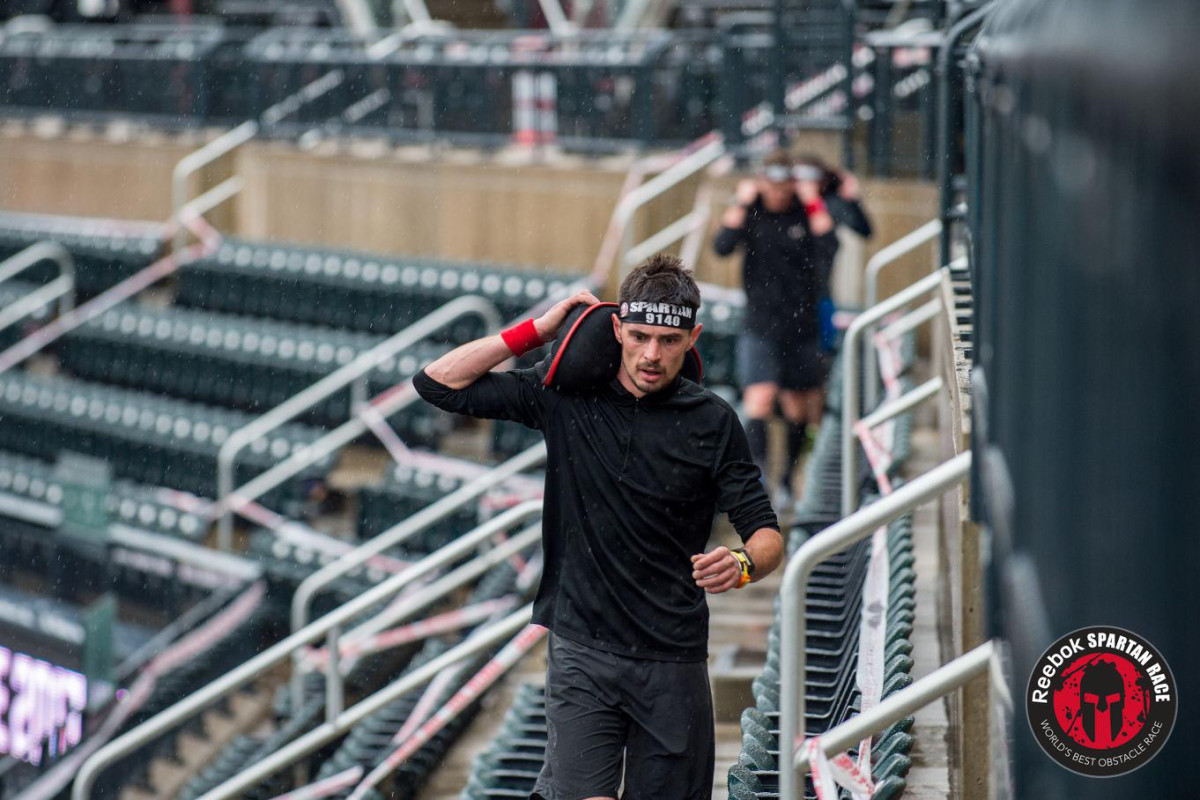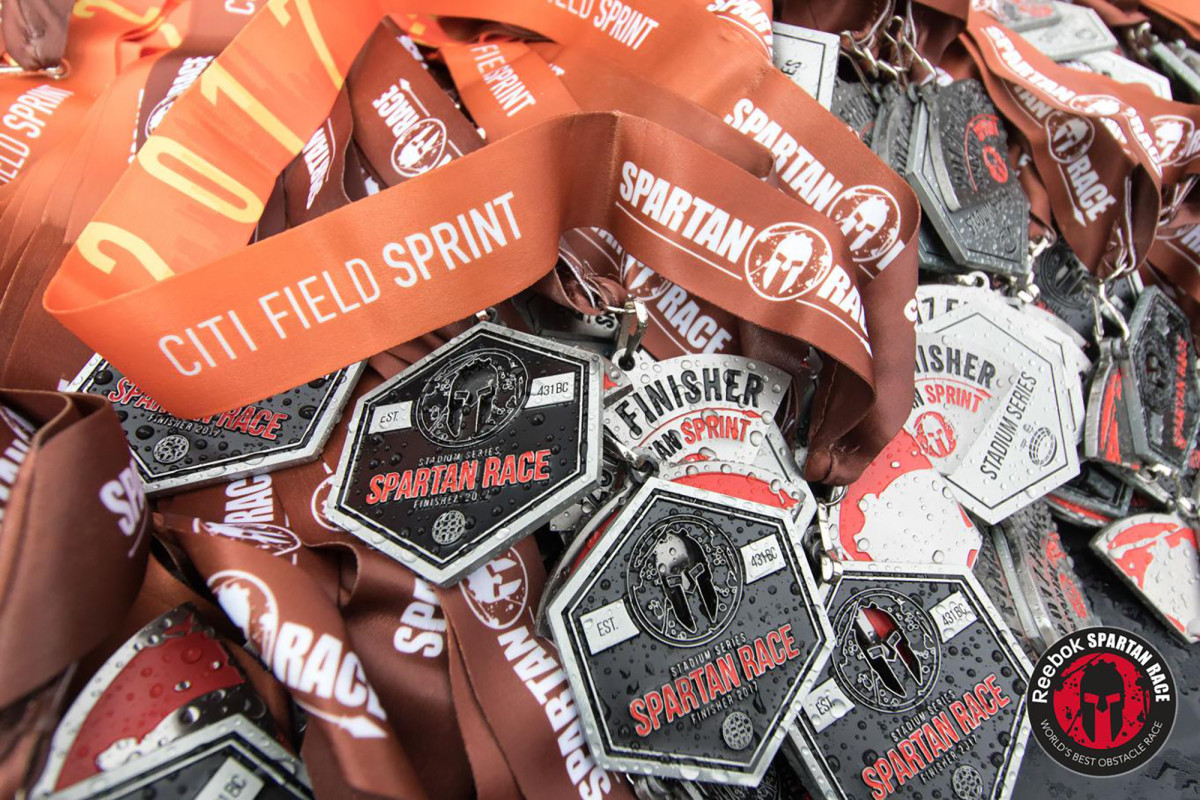What it’s like to do a Spartan Race without training for it

As I stand in line for the Spartan Race Stadium Series event outside of Citi Field, the massive brick facade of the stadium looms above me. The majority of the group is inched under a glass awning to avoid the cold rain that has been falling all morning.
Two guys in T-rex costumes walk by, and down on the field I can see someone in a bald eagle costume crossing the finish line near the dugout—those people have definitely done this before. Me? I’m attempting my first Spartan obstacle race course. And I haven’t trained for it.
All of the sudden, I’m at the starting point for my heat. I fly through the first few obstacles. I bear crawl up a flight of stairs, while crisscrossing lines of nylon rope hang a just slightly above me, forcing me to stay low. I feel one roll across my back as I get too high. (During outside Spartan Races, those that aren’t held in a stadium, these ropes would be replaced by barbed wire.)

At the top of the stairs is the next obstacle, a cargo climb. I clamber over this quickly, and touch down on the other side. For the next part, I place my feet on roller skates and drag my body to a distant line and back. We are somewhere near the back of the stadium, by one of the main food courts. A race official points up a flight of stairs and I gamely stomp up them. A few twists as the track takes us higher and higher until we emerge in the nose bleed bleachers. I pause for a moment. The track, marked by rope, leads all the way up to the last seat at the top, then takes out across one section, before pointing you down to the first seat at the bottom. It snakes like this all the way to the other side of the stadium.
“Stadium is hard,” says Cassidy Watton, a trainer at a local gym and an elite member of the Spartan Race Pro Team. “You are absolutely redlining your heart rate the entire time. There’s no pacing yourself, no saving yourself for later, if you’re trying to win, it’s nonstop. It’s a true sprint.”
Up and down. Up and down. We make our way laboriously across the nosebleeds, one rainy section at a time. Suddenly, the trail cuts into one of the tunnels. We run through the interior of the stadium for a few paces, to a large doorway. It’s a staircase. The trail is taking us to the very bottom of the stadium. And then all the way back up. My heart would sink if it wasn’t already hammering at 200 beats per minute.
12 Father's Day gift ideas for the active dad
Earlier that day, I asked Watton to walk me through a hypothetical training regimen. Watton has run, by her own count, more than fifty Spartan Races, having completed her first race in 2013, where she came in sixth place with minimal training. Watton is pure lean muscle, and with a couple of scars from barbed wire, tough as nails. She has begun to specialize in the Stadium Series.
“I would say three months to feel really good about yourself,” Watton says, of training for a Spartan Race, “Of course, anyone can hop in and I think that’s not a bad way to do it. A lot of people, they train for so long, they’re so nervous about their first race.”
Although there are differences between a Stadium Series and regular Spartan Race, mostly due to terrain and size constraints, Watton says there are tips you can use for both types, whether you’re climbing concrete or crawling through the mud.
“You need a good combination of strength training and running training and when you can, put the two together. I do a ton of interval training,” she says, “I actually train a lot more with High Intensity [interval] Training than a lot of other athletes in my sport do. That is where I’ve had my strength, and my strength and conditioning.”
Watton explained some details of her running workouts—specific training advice I wish I had before heading into the race.
Garmin Vivosmart 3 review: Testing out the tracker's stress monitoring, rep counter, more
“Long, low intensity your aerobic base, your middle interval, which is like mile repeats, 800 meter repeats. And then your sprint interval, which is 100s, 200s, and short hill repeats,” she says. “A lot of that aerobic work comes back to climbing. So I do a lot of stairs as well.”
As I make my way from the javelin throw in the parking lot, through the monkey bars and wooden walls, I end up back at the stairs again, only this time they’ve given us a weighted bag to lug around. Eventually, I wind my way down another few sets of stairs to the Hercules hoist. Here you have to lift a sand bag from the floor to the ceiling on a pulley system. I’m so elated not to be on the stairs that I effectively launch the bag to the ceiling and let it fall back down far too quickly. I won’t feel the rope burn for a few minutes.
The race continues out to the field where I grind through the outfield dirt and haul myself up the rope climb. The rain has made the rope incredibly slippery a few times I nearly lose my grip as my feet struggle to find purchase on the rope below me. I make it to the top ring the bell before accidentally fast-roping it to the bottom. There’s a raised jumping station, and then a stone throws away—the finish line. Ahead of me hang a dozen punching bags arranged like a gauntlet. I dodge the first swinging one, and then put my head down to push my way through the others.

Suddenly, I’m across the finish line. Someone puts a medal around my neck. When I had first heard about this practice, I was admittedly, a little skeptical. But honestly, rather than detract from or cheapen the experience, the medal solidifies it. I can’t show anyone the sense of accomplishment I feel, or the progression of mental fortitude that I have just experienced. I might be able to show them the bumps and bruises but everything is such a blur, I can’t remember where they’re from. And, while I can show them the medal—just like everything else I’ve just experienced, it’s not really for them. It’s for me. To remind me of what I just overcame, and of the fact that I will definitely being doing another Spartan Race in the near future. Maybe I’ll even train for it too.
